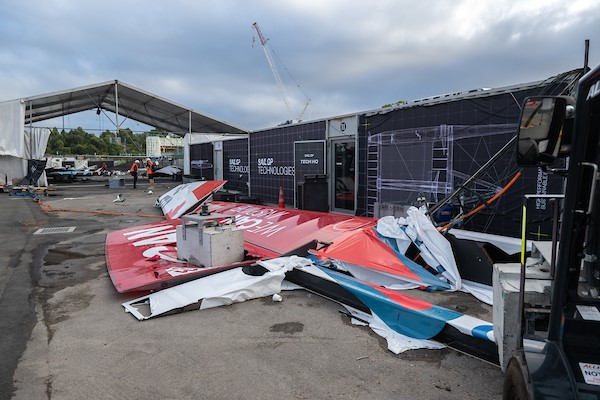SailGP Update: Substitute Sailor for US and Some Wild Wind
Chesapeake sailor Craig Ligibel, who frequently visits family in Australia, sends SpinSheet readers this report from the KPMG Australia SailGP (Grand Prix) event that unfolded in Sydney, February 18 to 19.

The exciting SAILGP racing action in Sydney was shortened to one day of racing due to a bizarre weather event that left the Canadian team’s boat and other F-50s severely damaged.
The United States team entered the high-flying F50 catamaran’s third Sydney event in need of a strong finish to claw themselves out of a lower-tier placing in the season’s overall standings.
“It’s not do or die for us,” team CEO and driver Jimmy Spithill told SpinSheet. “But we need to do well...and some other teams need to do poorly for us to have a chance at the San Francisco finals and that million dollar first prize.”
Sydney Harbor winds were as predicted: unpredictable. The 4 p.m. breeze from the northeast freshened as a storm front passed over the fleet. Boats were sailing with their smaller 18 meter wings expecting gusts in the 30-knot range.
The weatherman did not disappoint. Nine boats hit the line flying. When the dust and the fresh breeze settled, it was the French team with three bullets: an amazing bit of sailing given the conditions.
Spithill and company finished the day in overall second place with two strong seconds to their credit, despite having to sail with a substitute female athlete, Australia’s Lucy Copeland, after their female crew member, Erika Reineke, had to retire from racing after breaking her fibula on Thursday’s practice round.
“Lucy fit right in,” said Spithill. “She told the team she was here ‘to help us win.’ We appreciated her brassy Aussie attitude.”
Before the day’s racing was complete, the spectator fleet of around 1000 private vessels and a dozen huge motor launched were treated to thrills and almost spills as the teams tore around the short track with speeds approaching 35-40 knots.
One British crewman fell through his boat’s trampoline webbing and was dragged for a hundred yards or so until his fellow crewmen could retrieve him and get him back onboard. Most boats seemed to manage the fluky windy alright, but the Spanish boat, under the helm of a new skipper, provided excitement at the marks as she took to the air more than once only to come crashing down in a shower of foam.
Aussie boat driver Tom Slingsby who entered the Sydney event with a narrow lead over New Zealand’s team called the day’s racing 'challenging.’ “First we had the wind. Then the fleet packed tight at the starts. Our electronics failed us a couple of times, and we had to hand crank one of our foils on starboard tacks. Then, we think we we were ripping down the boundary only to look up and see a monstrous party boat blocking our vision…and our wind.”
Once all the boats were back in the staging area in front of the team’s base, things got interesting.

Microburst of Wind Slams Into SailGP Base
About half of the boats had been lifted out of the water by massive cranes that picked up the 2.5-ton boats like feathers and gently deposited them on land. They were then dismasted and wheeled into their temporary canvas sheds. The mix zone, where skippers fielded questions from journalists, was in full gear. Yours truly had just finished his interviews and was headed for an Uber for an hour ride home when all hell broke loose as a 40- to 50-knot microburst slammed into the team base.
The burst caught the Canadian boat in the worst of all positions as its 50-foot wing dangled precariously from the cable attaching it to the top of the crane. For a painful five minutes, the wing swung wildly back and forth tearing itself apart as it banged repeatedly into the ground while at the same time ripping the team’s base to shreds. Debris was flying around like we were in the outer wall of a tornado. Journalists and SailGP crew took cover wherever they could.
Spithill was pleased that no one was injured in the melee. “It was all-hands on deck… but ultimately Mother Nature won,” said Spithill.
Ultimately, SailGP officials canceled racing for the next day and, under terms of agreement, declared France the winner of the regatta with the US team coming in second.
The second-place finish and resulting points were good news for the struggling US team. Unfortunately, the French team picked up even more points and solidified their lead over the Americans with just two events remaining. The US team is 11 points out of third place behind France, Great Britain, and Denmark.
“We did good out there today,’ Spithill said. “The French did better. We need to keep sailing at a high level to make the finals in San Francisco.”
The next Sail GP event is scheduled for Christ Church in New Zealand, March 18-19, and the Grand Final, the United States Sail Grand Prix, is scheduled for San Francisco, May 6 - 7.
By Craig Ligibel




